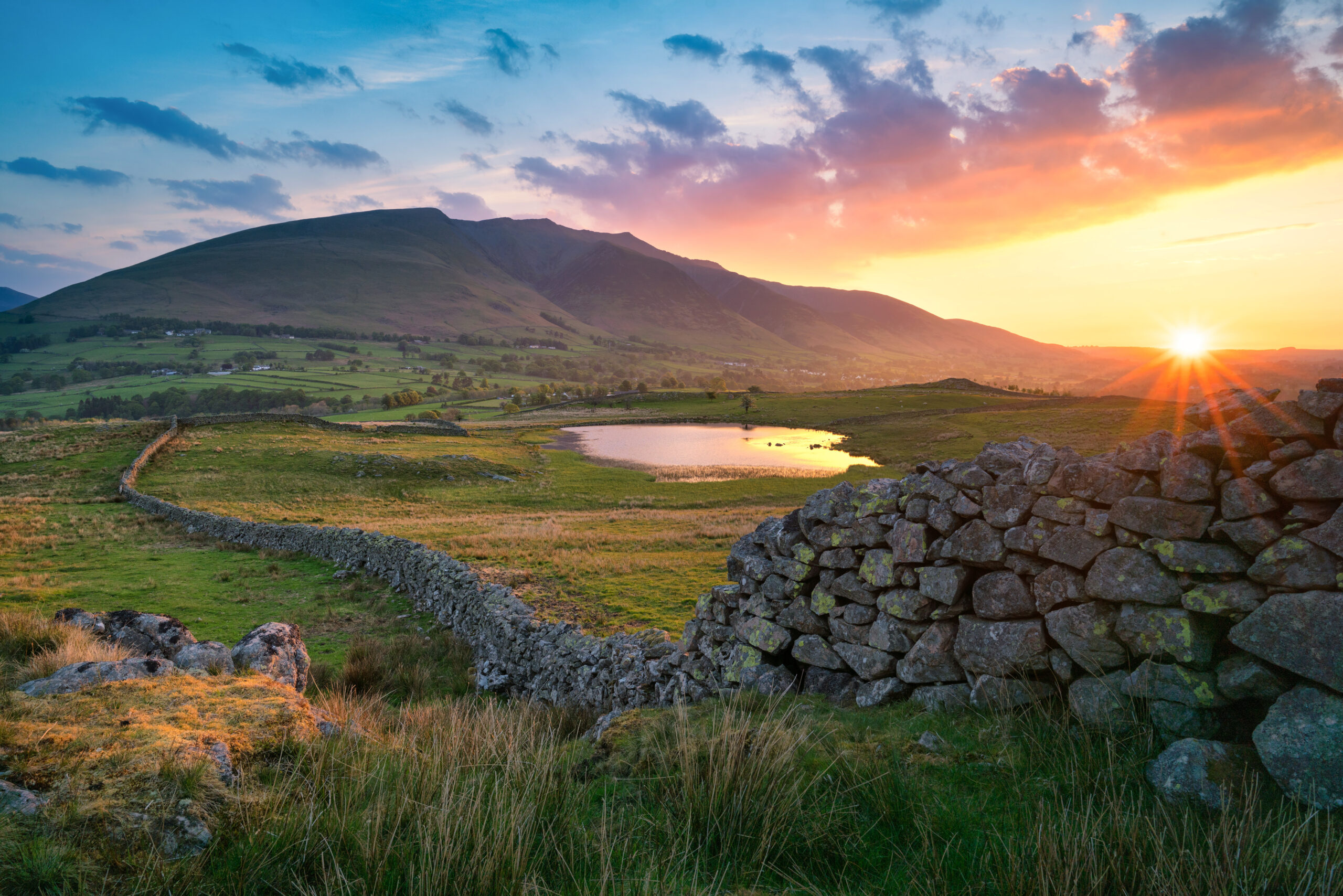Cumberland, once a historic county in its own right and now part of Cumbria, is a landscape where history and wilderness meet. To the north, its lands border Scotland, shaping centuries of frontier conflict and cultural exchange. To the west, the Solway Firth and Irish Sea provide coastal beauty and maritime heritage. To the south and east, the great fells of the Lake District rise in dramatic fashion, offering some of England’s most iconic scenery.
Cumberland’s identity has long been tied to its role as a frontier. Roman legions built Hadrian’s Wall across its lands, medieval lords constructed castles to defend against raids, and generations of border folk lived with both the hardship and resilience that came from straddling two cultures. Today, that history survives in ancient ruins, fortified towns, and enduring traditions.
Yet Cumberland is not only a land of defense and survival; it is also one of inspiration. The poets of the Romantic age, particularly Wordsworth, found beauty in its lakes and fells. The region’s rugged wilderness, from the depths of Wastwater to the heights of Skiddaw, continues to draw walkers, climbers, and dreamers from around the world.
In its towns and villages, Cumberland retains character and charm. Carlisle, the county’s historic capital, stands as a testament to endurance, while coastal towns like Whitehaven and Maryport recall maritime adventure and industrial energy. From Roman forts to Victorian piers, medieval churches to Georgian market squares, Cumberland tells England’s story in stone, water, and wind.
Carlisle
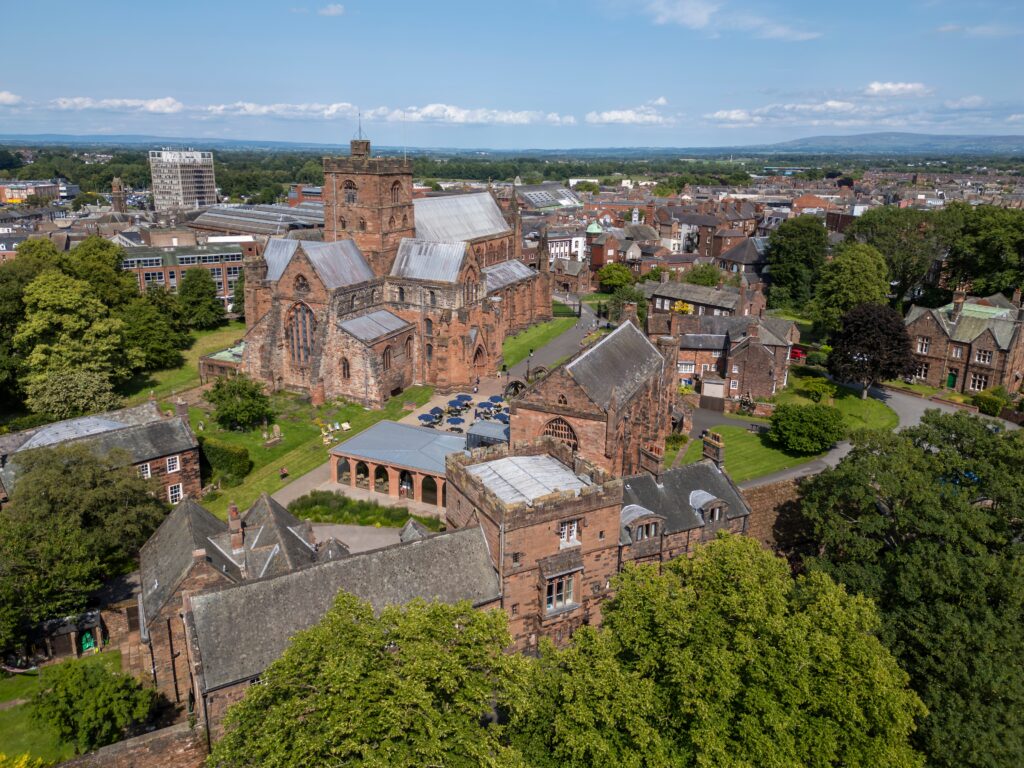
At the heart of Cumberland lies Carlisle, the historic county town and still the cultural capital of northern Cumbria. For over 2,000 years, Carlisle has been shaped by its role as a frontier city. Founded by the Romans as Luguvalium, it later became a vital stronghold in the wars between England and Scotland.
Carlisle Castle dominates the cityscape, a red sandstone fortress built by William II in the 11th century. For centuries, it stood as a bulwark against Scottish invasions and border skirmishes, housing kings, soldiers, and even Mary, Queen of Scots. Today, it remains one of England’s best-preserved castles, complete with battlements, dungeons, and exhibitions.
Nearby, Carlisle Cathedral, though modest in size, is rich in beauty. Its east window, filled with medieval stained glass, is among the finest in the country, while its intricate choir stalls and vaulted ceiling reflect centuries of devotion.
Carlisle also embraces its Roman heritage through sites like Tullie House Museum, which explores the city’s long history from Roman times to the present day. Its streets reflect a blend of medieval, Georgian, and Victorian architecture, while the market square remains lively with shops and cafés.
Modern Carlisle is a university city, lively yet grounded in its heritage. It is a place where past and present intertwine, making it the natural gateway to Cumberland.
Hadrian’s Wall
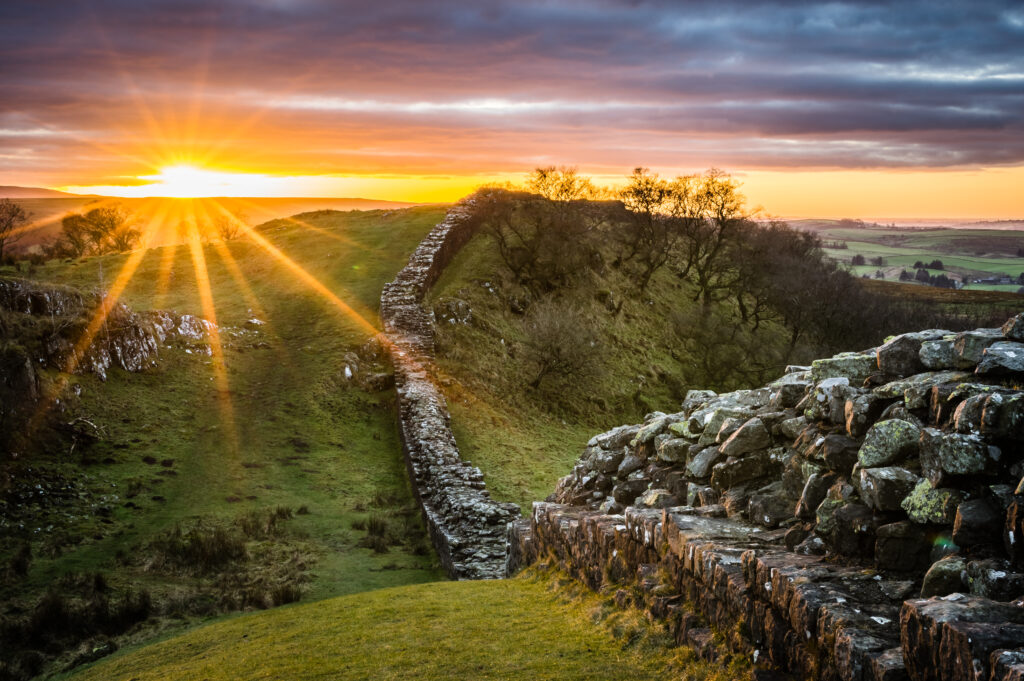
Stretching across northern England, Hadrian’s Wall is one of the greatest monuments of Roman Britain, and some of its most impressive sections run through Cumberland. Built in the early 2nd century AD under Emperor Hadrian, the wall marked the northern limit of the Roman Empire, a frontier both defensive and symbolic.
In Cumberland, the wall survives at sites such as Birdoswald Roman Fort, perched dramatically above the River Irthing. Here, visitors can walk along long stretches of wall, explore gatehouses and granaries, and imagine the lives of the soldiers stationed on this remote edge of empire.
Nearby stands Lanercost Priory, a haunting medieval ruin built with stones from the Roman wall itself, a reminder of how history layers upon history. The priory endured centuries of raids during the Anglo-Scottish wars, its crumbling arches now embodying resilience.
Walking along Hadrian’s Wall in Cumberland is an unforgettable experience. The sweeping views across rugged hills and farmland evoke the loneliness and grandeur of Rome’s frontier. Museums and visitor centres enrich the journey, but it is the landscape itself—wild, windswept, and timeless—that gives the wall its enduring power.
Solway Coast
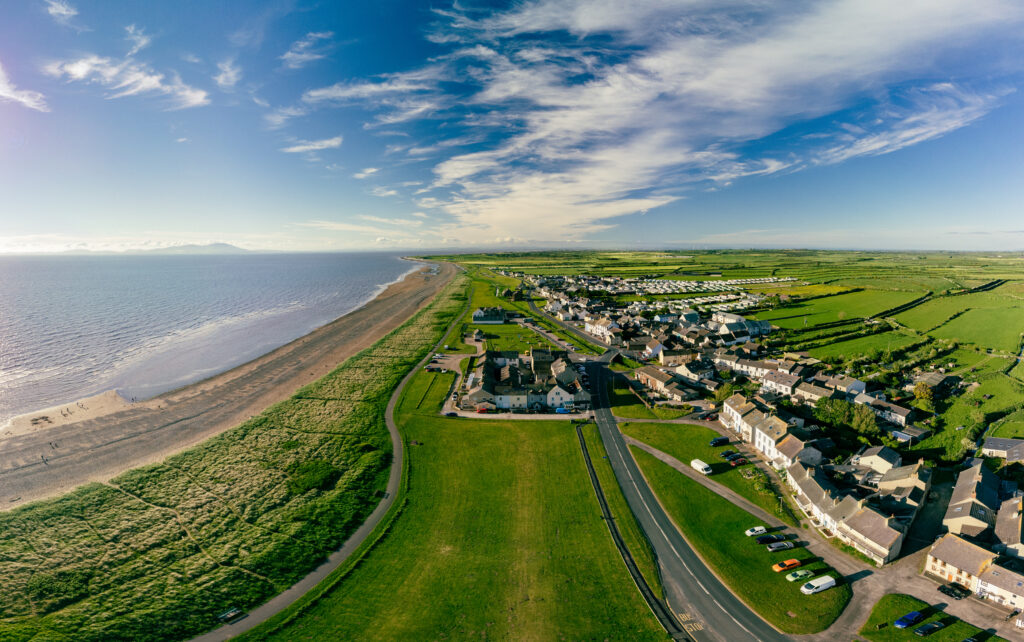
To the northwest, Cumberland meets the sea along the Solway Coast, an Area of Outstanding Natural Beauty. This stretch of coastline, where tidal estuaries meet sandy beaches and salt marshes, is one of England’s most atmospheric landscapes.
The Solway Firth has always been a place of crossing and connection. Romans, Vikings, and traders all left their mark, while smuggling was once a way of life along its remote shores. Today, the coast is prized for its wildlife, with flocks of migratory birds filling the skies and nature reserves preserving delicate ecosystems.
Villages such as Allonby, with its Georgian charm, and Silloth, a Victorian seaside resort, reflect the human history of the Solway. Fishing, farming, and holidaymaking have all shaped its identity. Walking along the shoreline, with views across to the Scottish hills, brings a sense of both remoteness and connection.
The Solway Coast embodies Cumberland’s frontier spirit—rugged, windswept, and full of stories. It is a place where land and sea meet, history lingers, and nature thrives.
Maryport
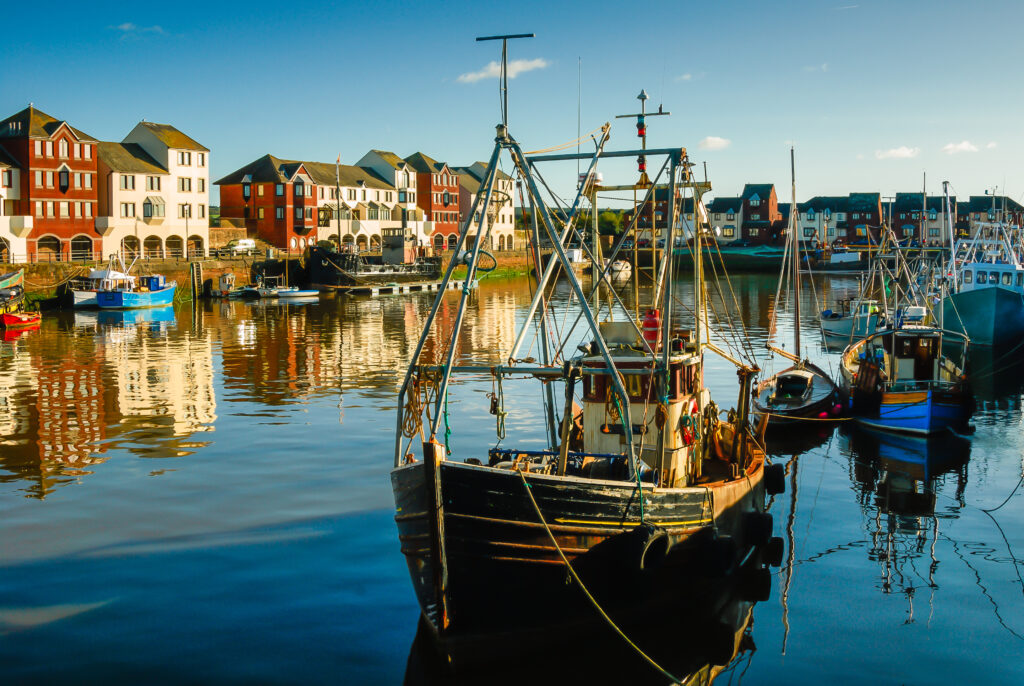
On the Solway Coast, Maryport tells a story of Roman frontiers and maritime resilience. Once home to a Roman fort called Alauna, the town has one of the richest collections of Roman altars and inscriptions in Britain, now displayed at the Senhouse Roman Museum overlooking the sea. From this vantage point, the Romans monitored shipping routes and guarded the empire’s northwestern flank.
Later, Maryport grew as a Georgian harbour town, its fortunes tied to coal exports, shipbuilding, and trade. The grid layout of its streets reflects careful planning during the 18th century, when prosperity filled its port. Though its industries declined in the 20th century, Maryport has reinvented itself as a centre of heritage and tourism.
Today, visitors enjoy its harbour, maritime museum, and annual blues festival. The town also offers access to the Solway Coast’s natural beauty, with beaches and coastal walks stretching in both directions. Maryport is a place where Roman stones, Georgian streets, and modern community spirit combine.
Workington
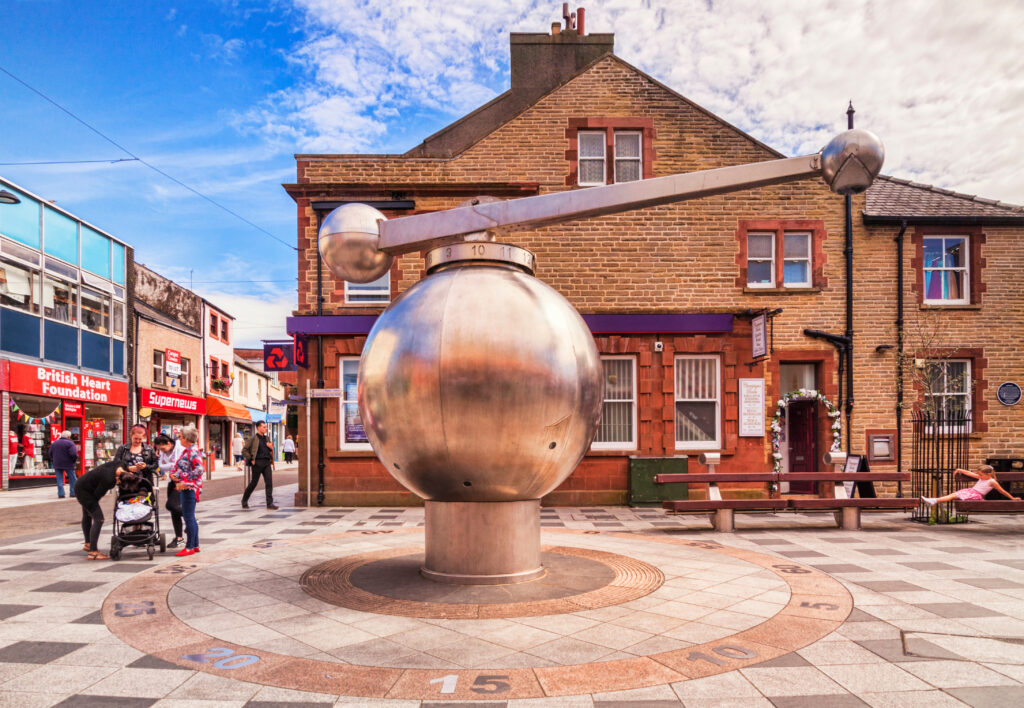
South of Maryport lies Workington, a town shaped by industry and endurance. For centuries, coal mining and steelmaking defined its identity, providing work and fuelling Britain’s industrial power. The town’s resilience is celebrated at the Helena Thompson Museum, which chronicles local history through exhibits on industry, fashion, and domestic life.
Workington Hall, now a romantic ruin, reflects the town’s earlier history. It was once the seat of the Curwen family and even sheltered Mary, Queen of Scots after her flight from Scotland. The ruins still stand amid parkland, a reminder of the town’s long timeline.
Modern Workington blends its industrial heritage with regeneration. The town centre has been revitalised, with shops, leisure spaces, and cultural venues. Rugby and football remain important to community life, while the surrounding countryside offers opportunities for outdoor recreation.
Workington is a town of grit and history, embodying Cumberland’s working-class strength and adaptability.
Whitehaven
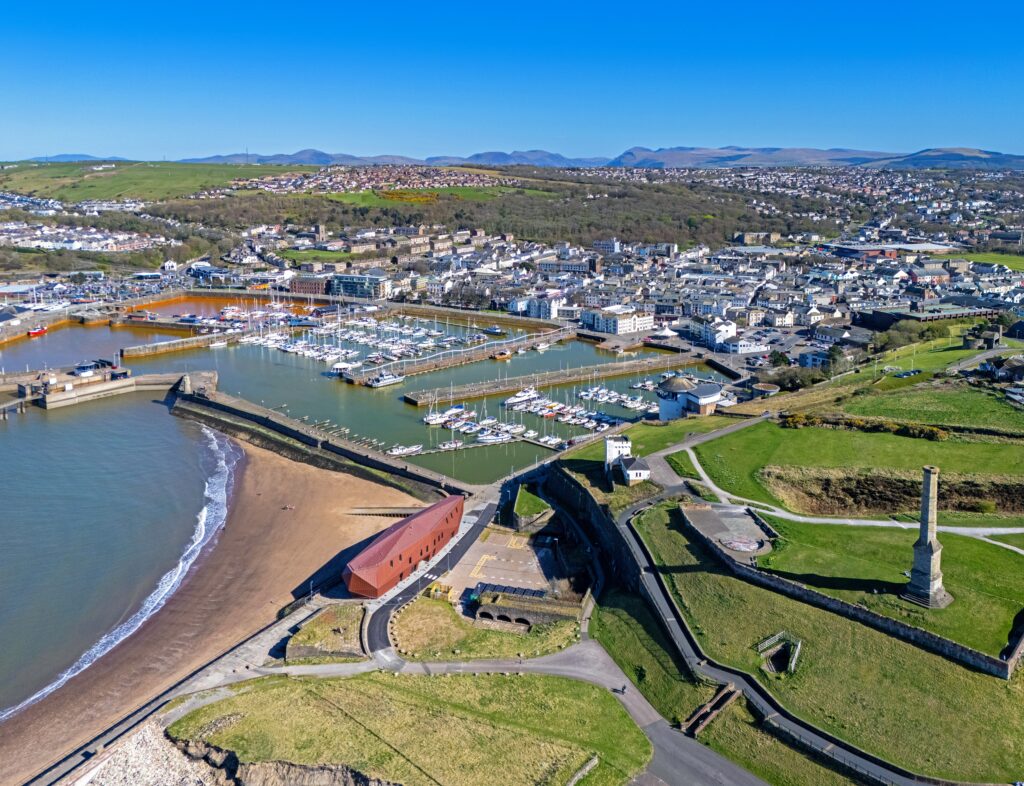
Few towns reflect 18th-century planning as clearly as Whitehaven, a Georgian harbour town once central to Britain’s maritime trade. Developed by the Lowther family, Whitehaven became a hub for coal export, shipbuilding, and international commerce. Its streets were laid out in a grid pattern, inspired by the cities of the New World.
The town’s stories are told through attractions such as The Rum Story, which explores Whitehaven’s role in the rum and sugar trade, and the Beacon Museum, which offers insights into maritime history. Its harbour, now redeveloped, hosts events and leisure activities, while still evoking the town’s seafaring past.
Whitehaven also has a darker legacy, tied to the transatlantic trade, but today it embraces its complex history openly, using heritage as a tool for education and renewal.
Surrounded by sea and hills, Whitehaven is a town of striking character—georgian streets, a working harbour, and a sense of resilience that mirrors Cumberland itself.
St Bees & St Bees Head
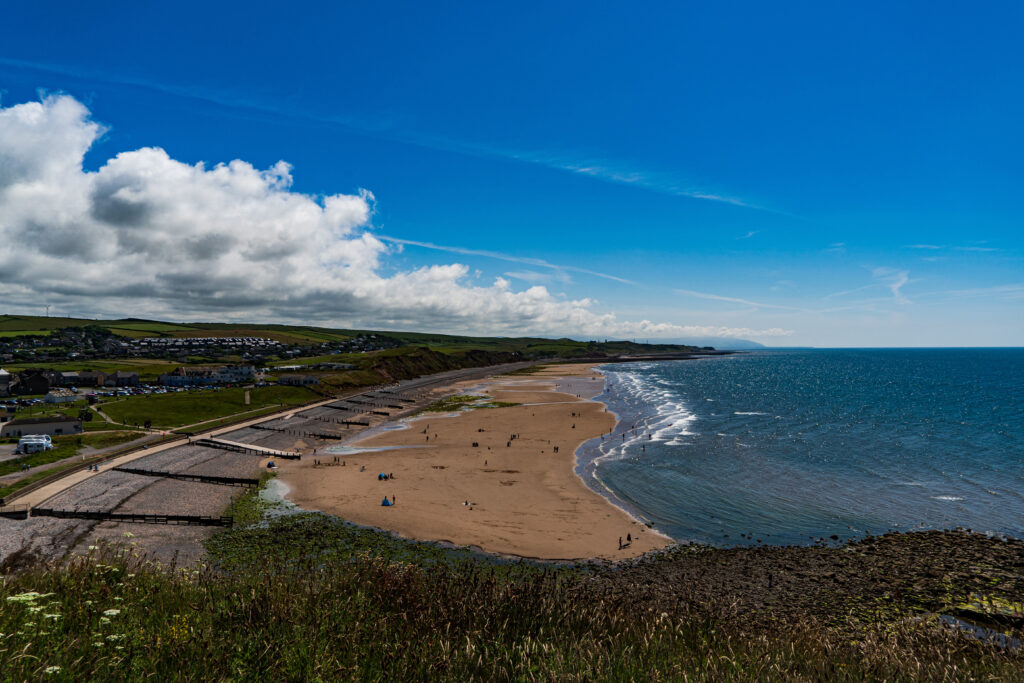
The coastal village of St Bees is one of Cumberland’s treasures, known for its long sandy beach and historic priory. The St Bees Priory Church, founded in the 12th century, is one of the county’s finest medieval buildings, with Norman arches and Gothic details reflecting centuries of devotion. Inside, the preserved body of a 14th-century knight, the “St Bees Man,” was discovered, adding mystery to its history.
Above the village rises St Bees Head, the only heritage coast between Wales and Scotland. Its red sandstone cliffs are home to England’s largest seabird colony outside the Farne Islands, with puffins, guillemots, and kittiwakes filling the skies in spring and summer. Walkers enjoy dramatic cliff paths with sweeping sea views.
St Bees is also the starting point of the famous Coast to Coast Walk, linking the Irish Sea to the North Sea across England. With its blend of heritage, wildlife, and natural beauty, St Bees captures the essence of Cumberland’s coast.
Egremont
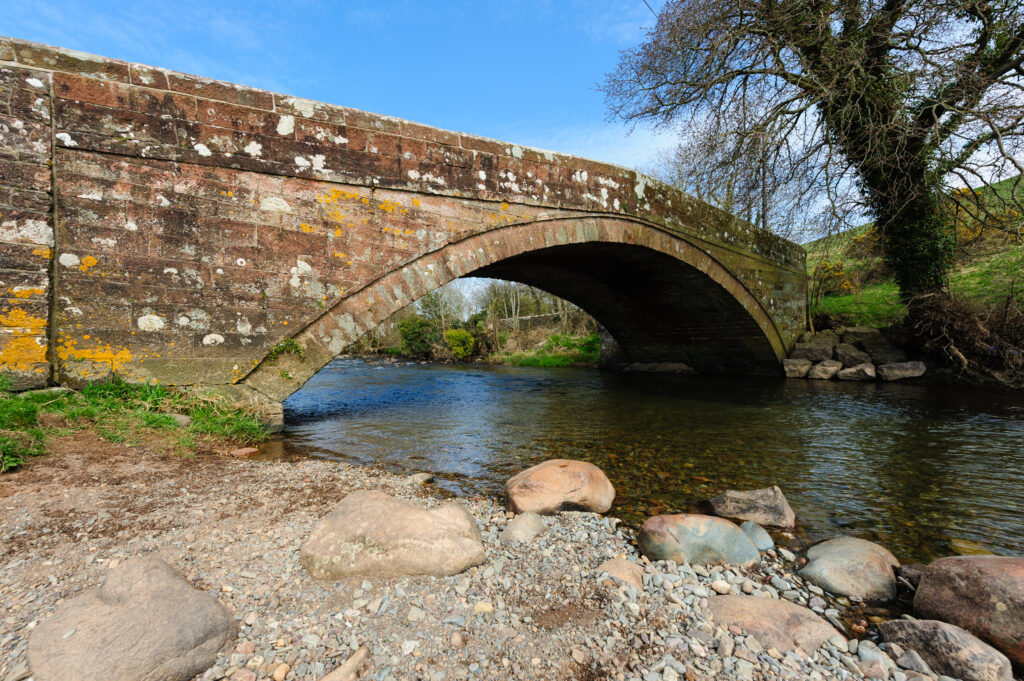
Just inland from the coast, Egremont is a small market town with a big personality. Dominated by the ruins of Egremont Castle, which date from the 12th century, the town has long been a focal point of the area. The castle, though ruined, still stands proudly above the River Ehen, evoking the turbulence of medieval border life.
Egremont is best known for its annual Crab Fair, one of the oldest fairs in the world, dating back to 1267. The event features the quirky and famous gurning competition, where contestants pull the funniest faces through a horse collar—a tradition unique to the town.
The surrounding landscape adds to Egremont’s charm, with easy access to both the coast and the Lake District fells. The town’s friendly character, medieval heritage, and eccentric traditions make it a true highlight of Cumberland’s cultural life.
Cockermouth
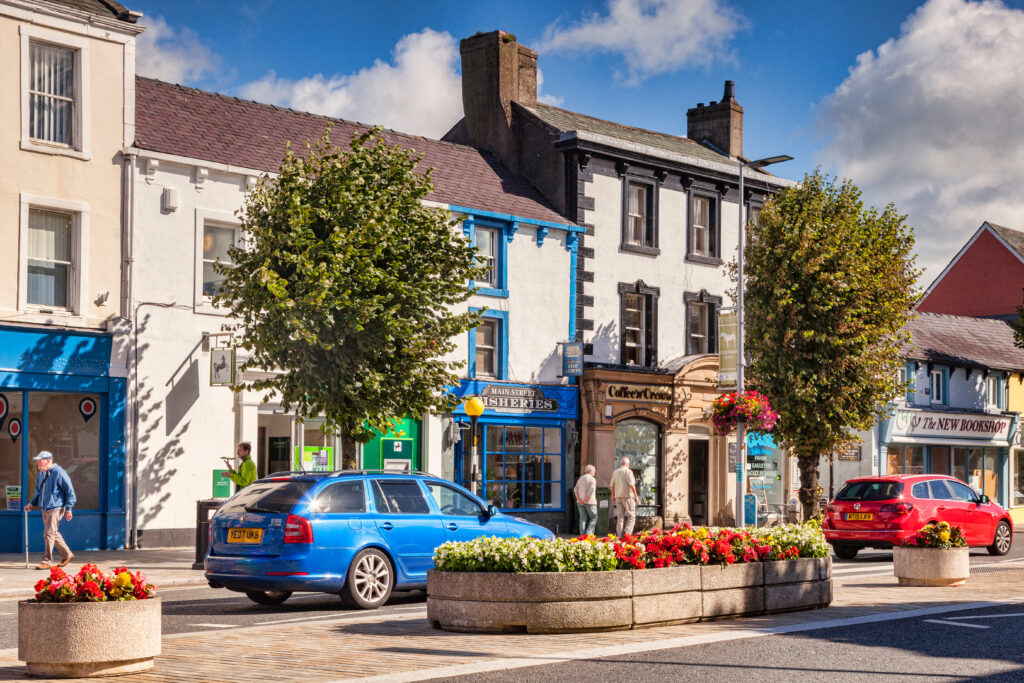
Cockermouth is one of Cumberland’s most attractive market towns, rich in history and culture. Its claim to fame is as the birthplace of William Wordsworth, whose childhood home on Main Street is now a museum that brings the poet’s early years vividly to life.
The town itself reflects centuries of prosperity. The confluence of the Rivers Cocker and Derwent gave Cockermouth its name and its strategic position. Cockermouth Castle, though now a ruin, reminds visitors of the town’s medieval strength. Georgian and Victorian buildings line its streets, while its historic market square remains the lively heart of the community.
Modern Cockermouth has developed a reputation for food, drink, and culture. The Jennings Brewery, established in the 19th century, continues to brew traditional ales, and the town hosts festivals ranging from literature to music. Independent shops and galleries reinforce its creative character.
Cockermouth combines literary heritage, historic architecture, and cultural vitality, making it a perfect gateway to the western Lake District.
Keswick
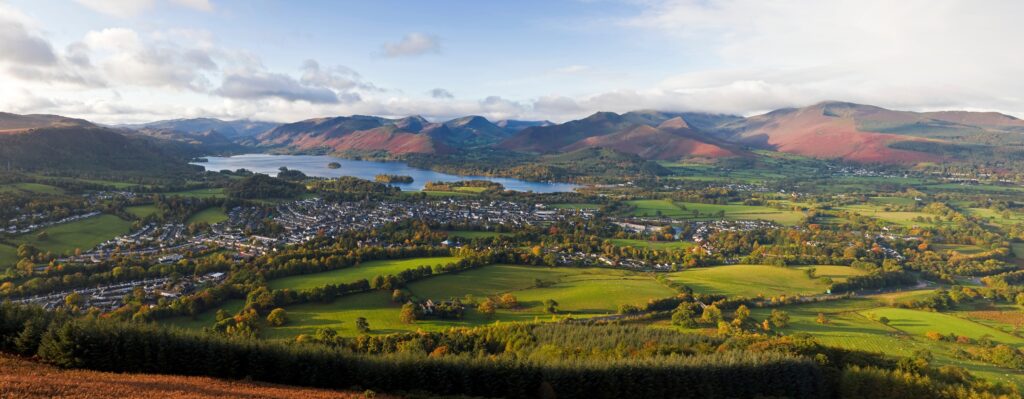
Nestled between mountains and lake, Keswick is often regarded as the capital of the northern Lake District. Its setting on the shores of Derwentwater, framed by Skiddaw and Catbells, is among the most beautiful in England.
Keswick grew as a market town, but in the 18th and 19th centuries it transformed into a centre for tourism. The Romantic poets, including Wordsworth and Coleridge, celebrated its landscapes, drawing visitors in search of inspiration.
Today, Keswick thrives as a hub for outdoor adventure. Walking, climbing, boating, and cycling all begin here, while its town centre is filled with outdoor shops, cosy pubs, and vibrant markets. Cultural life flourishes at the Theatre by the Lake, and museums such as the Cumberland Pencil Museum reflect the area’s unique industrial heritage.
Keswick balances its role as a tourist hub with genuine community warmth, offering both energy and tranquillity at the heart of the Lakes.
Derwentwater & Borrowdale Valley
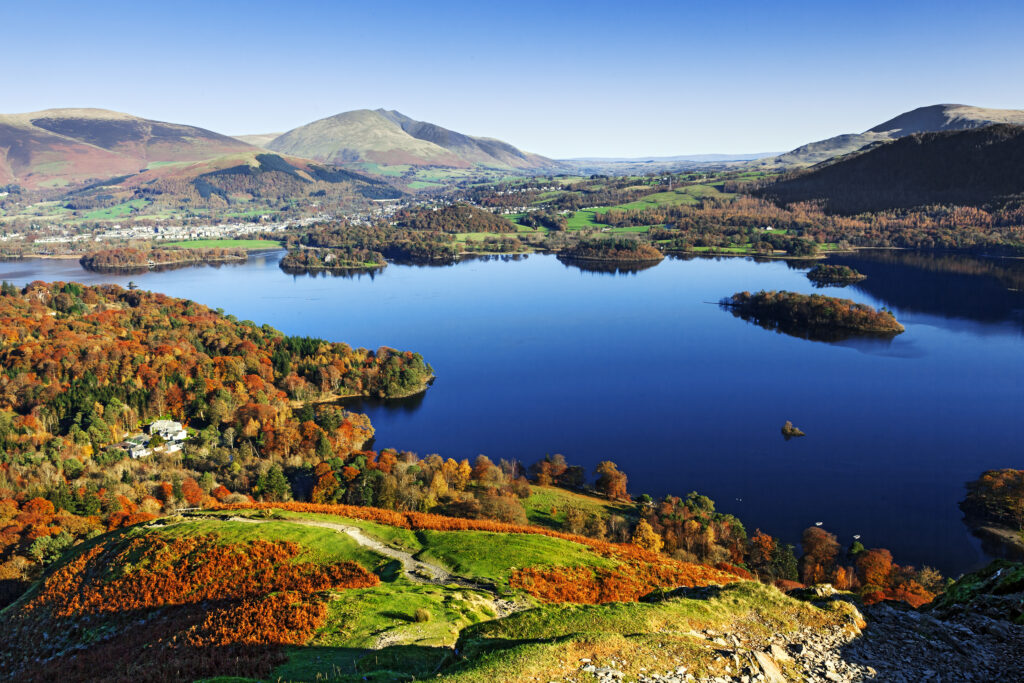
Few places embody the Lake District’s beauty more than Derwentwater and the Borrowdale Valley. Derwentwater, with its wooded islands and encircling hills, has been called the “Queen of the Lakes.” Its waters shimmer beneath Catbells and Skiddaw, offering endless opportunities for boating, walking, and quiet contemplation.
At its southern end lies the Borrowdale Valley, one of the most dramatic in the region. Steep fells, ancient oak woods, and tumbling rivers create a landscape that has inspired generations. Villages such as Grange and Rosthwaite add rustic charm, with stone cottages and traditional inns.
Borrowdale is also known for its geological history—the valley was once a centre for graphite mining, the raw material that gave rise to the pencil industry in nearby Keswick. Today, it is a paradise for walkers, with routes ranging from riverside strolls to challenging climbs.
Together, Derwentwater and Borrowdale offer an almost perfect blend of natural grandeur and human scale.
Bassenthwaite Lake
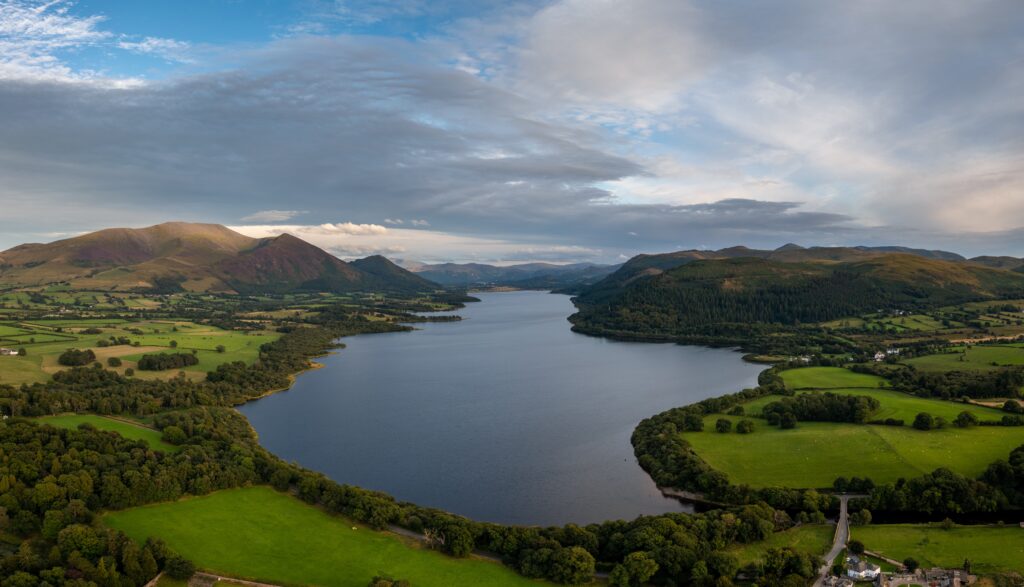
Unique among the Lakes, Bassenthwaite is one of the few officially called a “lake” rather than a “mere” or “water.” It lies in a long, shallow valley beneath the slopes of Skiddaw and Dodd, creating one of the most tranquil and expansive views in the district.
Bassenthwaite is celebrated for its wildlife. The Lake District Osprey Project has reintroduced these magnificent birds of prey, and visitors often gather at viewpoints to watch them hunt over the water. Otters, herons, and countless smaller birds also thrive in its wetlands and reed beds.
The lake’s quietness contrasts with the busier waters of Windermere or Derwentwater. Sailing, fishing, and gentle walking are popular here, but it is the sense of peace that defines Bassenthwaite. Nearby, the village of Bassenthwaite and attractions such as Mirehouse, a historic house with literary connections, add cultural depth.
Bassenthwaite Lake is a reminder that beauty in the Lakes is not only dramatic, but also serene.
Skiddaw
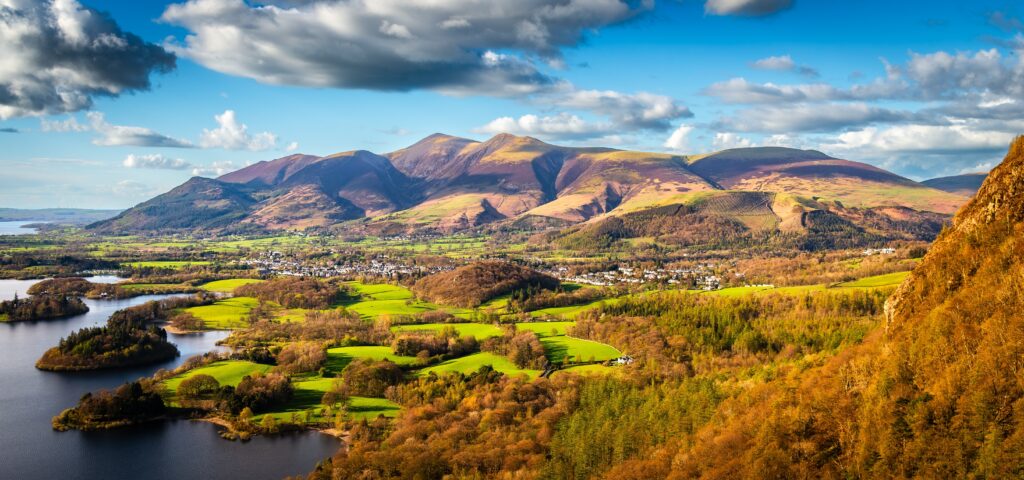
Towering above Keswick and Bassenthwaite, Skiddaw is one of the Lake District’s great mountains. At 931 metres (3,054 feet), it is the fourth-highest peak in England, yet its broad slopes and accessible paths make it one of the most climbed.
Skiddaw offers a striking contrast to the jagged ridges of Helvellyn or Scafell. Its rounded summit rises smoothly, but the views from the top are among the most expansive in the country—taking in Derwentwater, Bassenthwaite, Solway Firth, and even the mountains of Scotland on a clear day.
The fell has long inspired visitors. Early tourists in the 18th century climbed it for the sublime experience of vast landscapes, and the tradition continues today. Though challenging, Skiddaw’s routes are suitable for many walkers, making it a beloved introduction to high fell-walking.
Skiddaw is more than a mountain; it is a symbol of Cumberland’s northern Lakes—majestic, approachable, and unforgettable.
Buttermere & Crummock Water
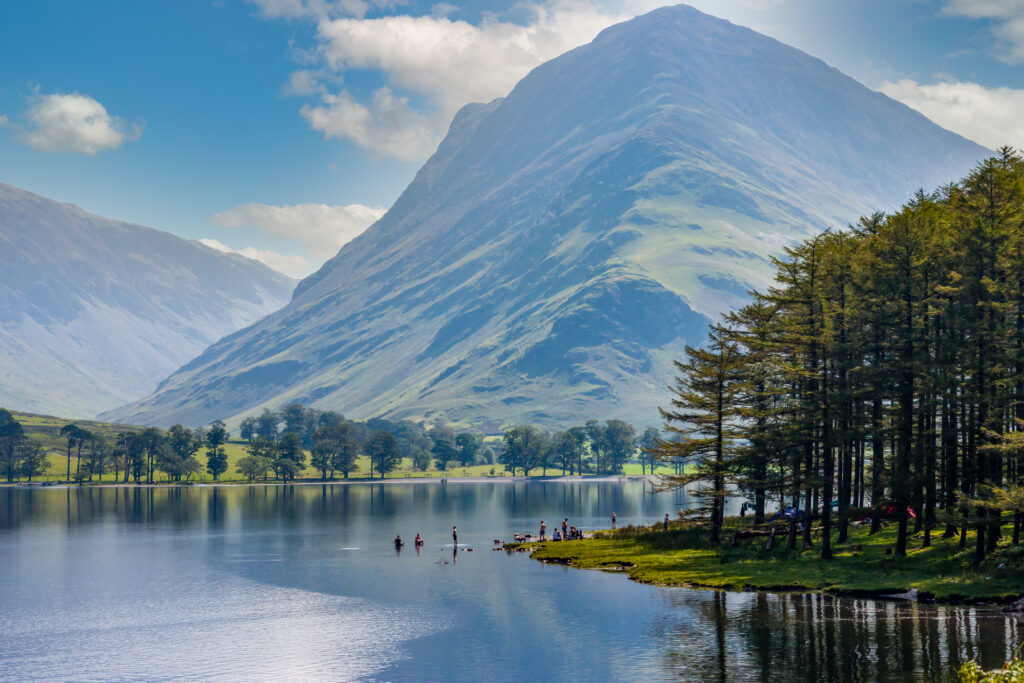
Buttermere and its neighbour Crummock Water form one of the most iconic landscapes in the Lake District. Surrounded by steep fells such as Haystacks, High Stile, and Grasmoor, these lakes are beloved for their drama and tranquillity.
Buttermere, smaller and more intimate, is celebrated for its mirror-like reflections. The circuit walk around the lake is among the most popular in the Lakes, offering easy access to spectacular views. Crummock Water, larger and wilder, stretches northward beneath rugged mountains, fed by waterfalls such as Scale Force, the highest in the district.
The valley is also linked to the memory of Alfred Wainwright, who cherished Haystacks as his favourite fell. His ashes were scattered here, adding to the area’s poetic aura.
With its beauty, tranquillity, and literary associations, the Buttermere Valley embodies the essence of Lakeland splendour.
Ennerdale
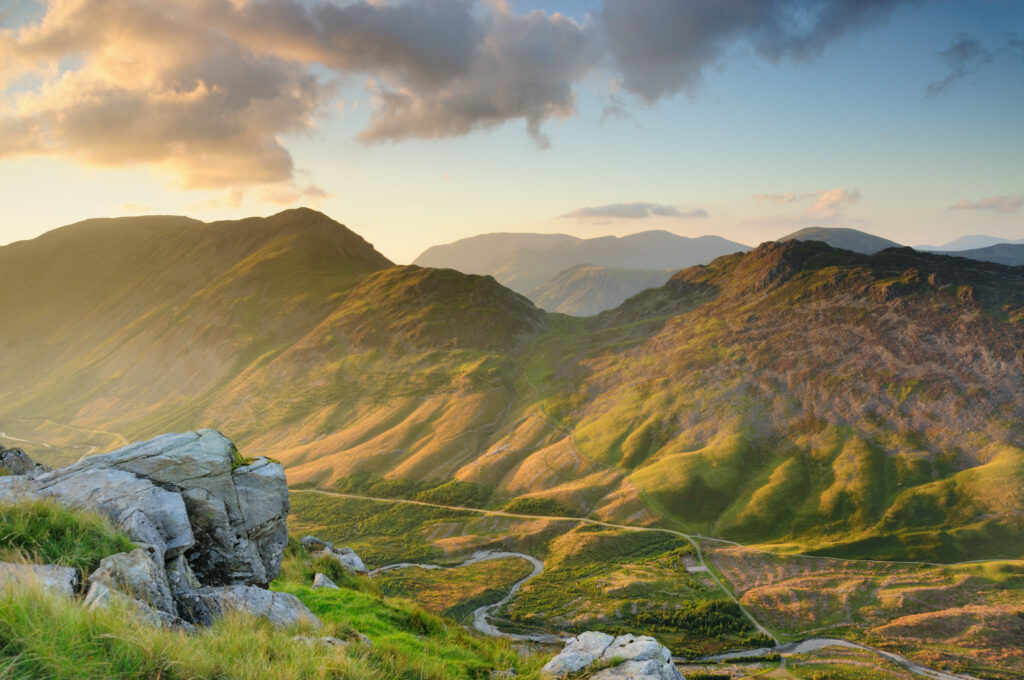
Remote and untamed, Ennerdale is one of the least developed valleys in the Lake District. Without major roads or villages, it offers a rare sense of wilderness in modern England. Ennerdale Water, its lake, lies beneath craggy fells such as Pillar and Great Gable, creating a scene of stark beauty.
Ennerdale has become a focus for conservation. The Wild Ennerdale Project seeks to rewild the valley, allowing natural processes to shape the landscape. Forests, rivers, and wildlife are being restored, creating a habitat for red squirrels, deer, and birdlife.
Walking in Ennerdale is a different experience from other valleys: quieter, lonelier, and more primal. It appeals to those seeking solitude and a connection with nature at its rawest. Ennerdale reminds us that Cumberland’s fells are not only picturesque but also wild and powerful.
Loweswater
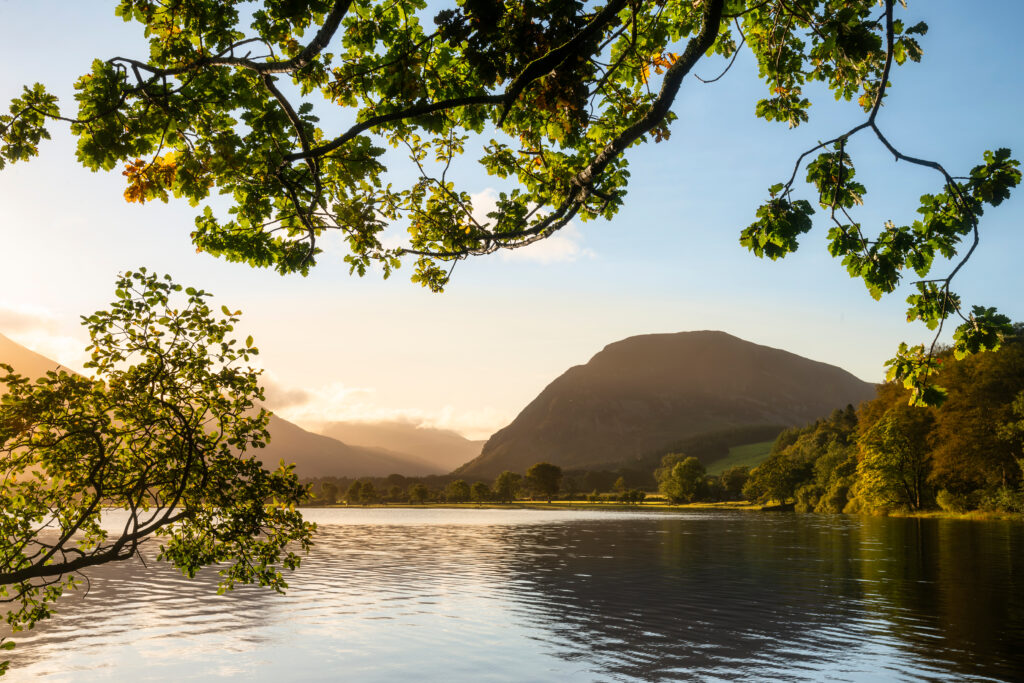
Lesser known but deeply charming, Loweswater is a small lake tucked into a quiet valley west of Crummock Water. Surrounded by woodland and gentle slopes, it offers peace away from the busier tourist routes.
A unique feature is that Loweswater drains northward, away from the central lakes, via the River Cocker—an oddity in Lakeland hydrology. Its setting, with the Holme Wood plantation and views towards Grasmoor, provides a sense of intimacy and seclusion.
The surrounding villages and farms maintain a traditional feel, while paths around the lake are popular with walkers seeking calm. For those who value understated beauty, Loweswater is a gem—modest in scale but rich in atmosphere.
Caldbeck & the Northern Fells
On the northern fringe of the Lake District, Caldbeck is a picturesque village that reflects rural Cumberland at its best. Stone cottages cluster around a beck, while the village green and church provide timeless charm.
Caldbeck is closely associated with the legendary John Peel, the famous huntsman celebrated in song, who is buried in the local churchyard. The village also has a tradition of weaving and crafts, with artisans continuing to thrive here.
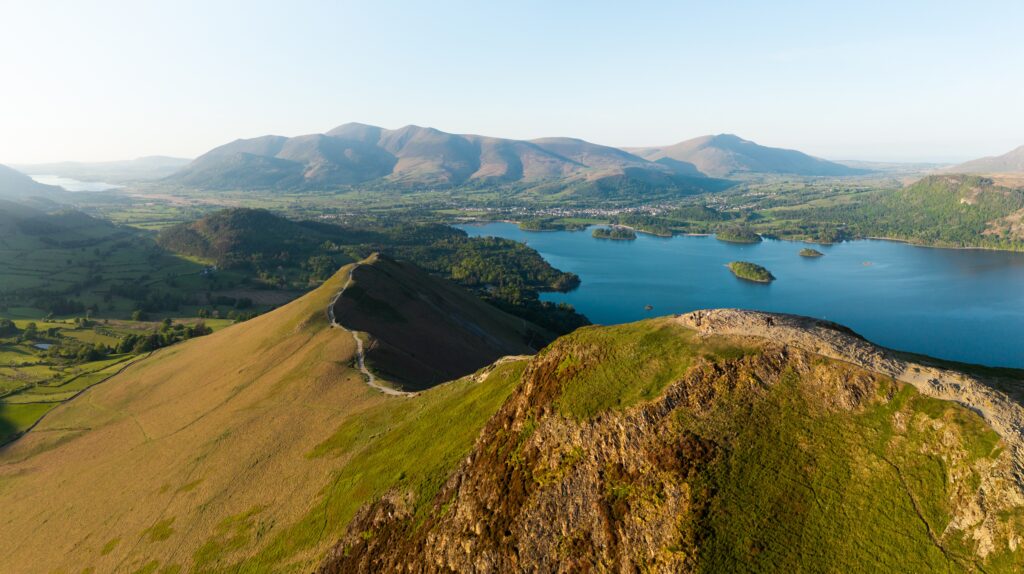
The surrounding Northern Fells offer wide, rolling landscapes quite different from the craggy central Lakes. Peaks such as Carrock Fell and High Pike provide exhilarating walking with fewer crowds, while the open moorland and sweeping views across the Solway Plain give a sense of space and freedom.
Caldbeck and its fells show another face of Cumberland—pastoral, open, and steeped in local lore.
Blencathra
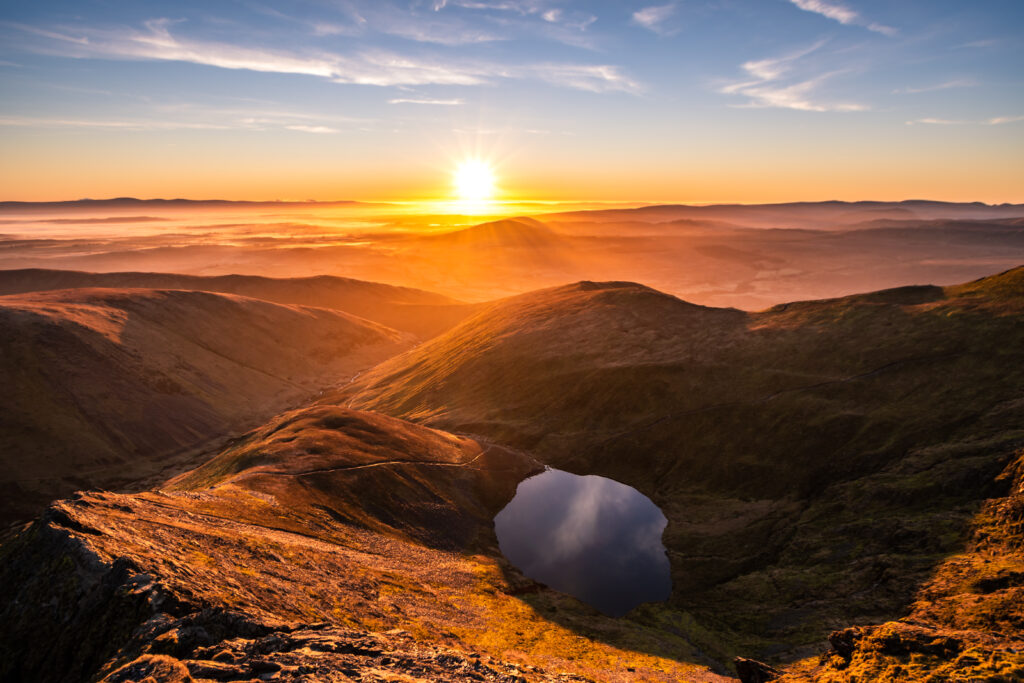
Few mountains are as instantly recognisable as Blencathra, also known as Saddleback. Its sweeping ridges and dramatic profile dominate the northern Lake District, drawing climbers and walkers for centuries.
The mountain’s most famous feature is Sharp Edge, a narrow arête that provides one of the most thrilling—and dangerous—scrambling routes in the country. For experienced climbers, it is a rite of passage; for others, the gentler routes to the summit offer equally rewarding views.
Blencathra has deep cultural resonance. Its name is rooted in Cumbric, a reminder of the Celtic languages once spoken here, and the mountain has long been a landmark for travellers. In 2014, it even made headlines when the Earl of Lonsdale offered it for sale, sparking debates about heritage and conservation.
Today, Blencathra stands as a symbol of Cumberland’s rugged spirit—majestic, challenging, and unforgettable.
Penrith

Although technically just beyond historic Cumberland’s borderlands, Penrith has long served as a gateway town for the Eden Valley and northern Lakes. Its history stretches back to Roman times, when it guarded key routes across the north.
The ruins of Penrith Castle, built in the 14th century to defend against Scottish raids, still stand near the town centre. Penrith’s parish church and market square reflect its medieval prosperity, while its narrow streets and yards contain a mixture of Georgian and Victorian architecture.
Penrith is also known for its role as a coaching town. Its position on routes between England and Scotland made it a natural stop, and its inns, many still in use, echo that heritage. Today, it remains a lively market town, with independent shops, cafés, and a strong sense of identity.
With its castle ruins, historic buildings, and strategic setting, Penrith continues to embody Cumberland’s borderland character.
Eden Valley

The Eden Valley, lying between the Pennines and the Lake District, is one of Cumberland’s most beautiful yet less-visited landscapes. The River Eden flows through fertile farmland, meadows, and charming villages, creating a region of quiet loveliness.
Stone-built settlements such as Kirkoswald, Appleby-in-Westmorland, and Armathwaite preserve traditional architecture and community spirit. Castles, churches, and bridges dot the valley, adding layers of history. The area’s agricultural heritage remains strong, with livestock farming shaping both the economy and the scenery.
The Eden Valley is also prized for its walking and cycling routes. Paths follow the river, wind through villages, and climb towards the Pennine fells, offering endless variety. Its slower pace and pastoral charm make it an antidote to the busier parts of the Lake District.
The valley’s blend of history, landscape, and tranquillity shows Cumberland at its most quietly enchanting.
Long Meg & Her Daughters Stone Circle
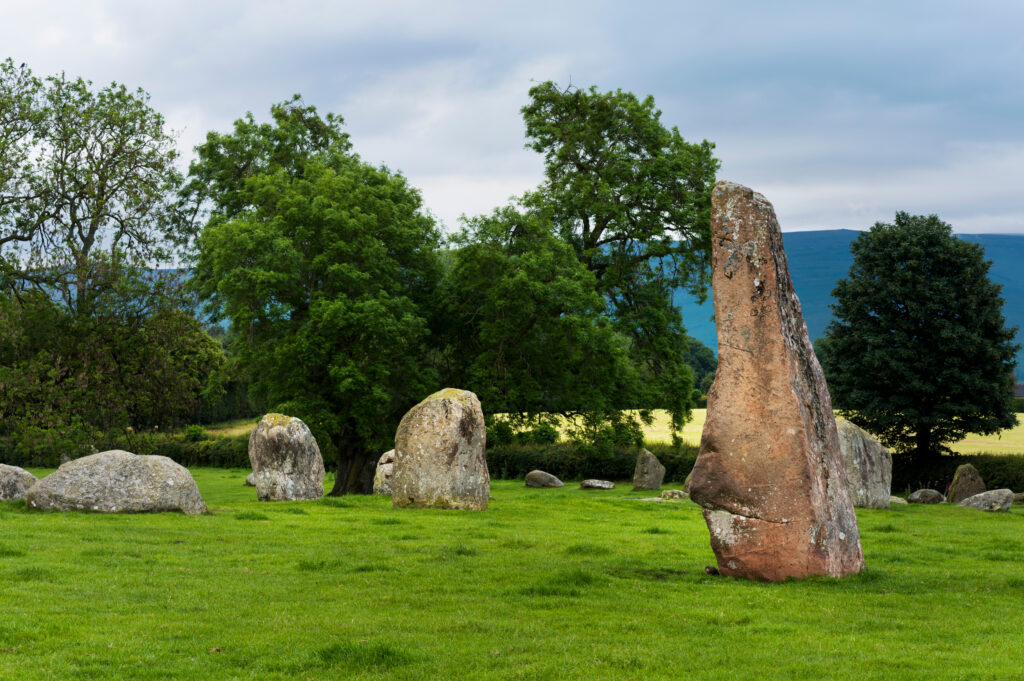
One of the most mysterious sites in Cumberland is the Long Meg and Her Daughters Stone Circle, near Penrith. Dating back to around 1500 BC, it is among the largest stone circles in Britain, consisting of over 50 stones arranged in an oval.
Legend surrounds the site. Long Meg, a tall sandstone pillar, is said to represent a witch turned to stone along with her “daughters.” Folklore insists the stones cannot be counted the same way twice, adding to their aura of mystery.
The circle is part of a wider prehistoric landscape, suggesting it was used for rituals, gatherings, or astronomical purposes. From its site, there are views across the Eden Valley to the Pennines, reinforcing its spiritual and symbolic presence.
Visiting Long Meg is a powerful experience—standing among the stones, one feels connected to a distant past, when the people of Cumberland marked the land with monuments that still endure.
Greystoke
The village of Greystoke, near Penrith, is steeped in history and legend. Its name is associated with the Greystoke family, whose lineage dates back to medieval times, and the village is thought to have inspired aspects of the fictional world of Tarzan, created by Edgar Rice Burroughs, who used the name “Lord Greystoke.”
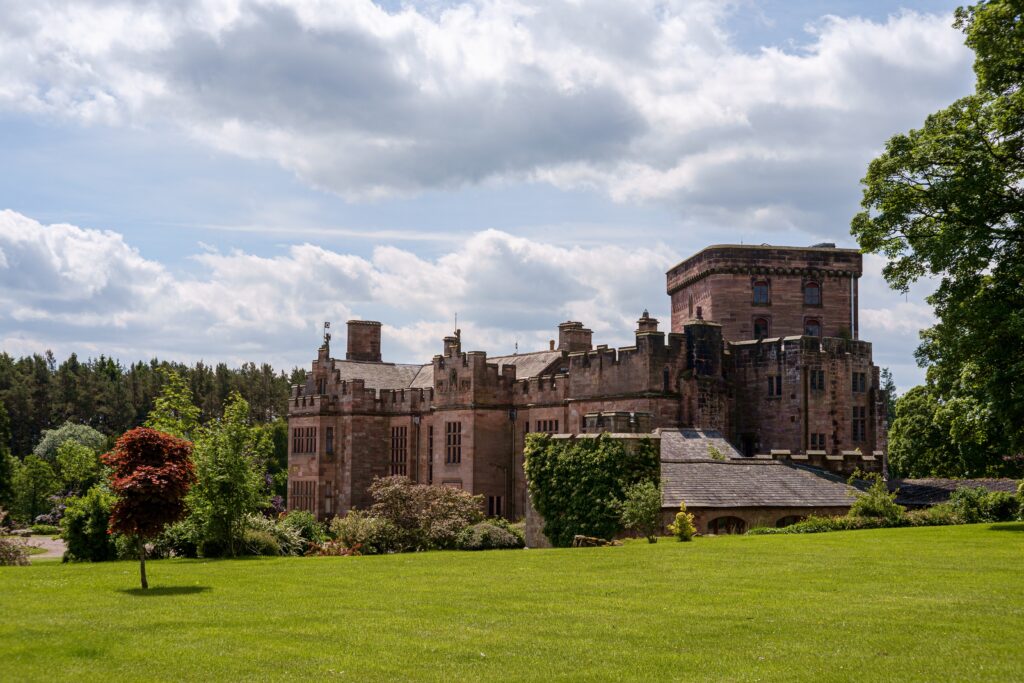
At the heart of the village stands Greystoke Castle, rebuilt in the 19th century after earlier destruction. While not generally open to the public, it remains a landmark of the area. The parish church of St Andrew, with its fortified tower, reflects the need for defence in these borderlands.
Greystoke is also a hub for modern cycling and outdoor activities. Routes from the village lead into the Eden Valley and northern Lake District, making it a popular base for riders and walkers.
With its mix of medieval legacy, romantic associations, and active outdoor life, Greystoke is a small place with a big story.
Allonby
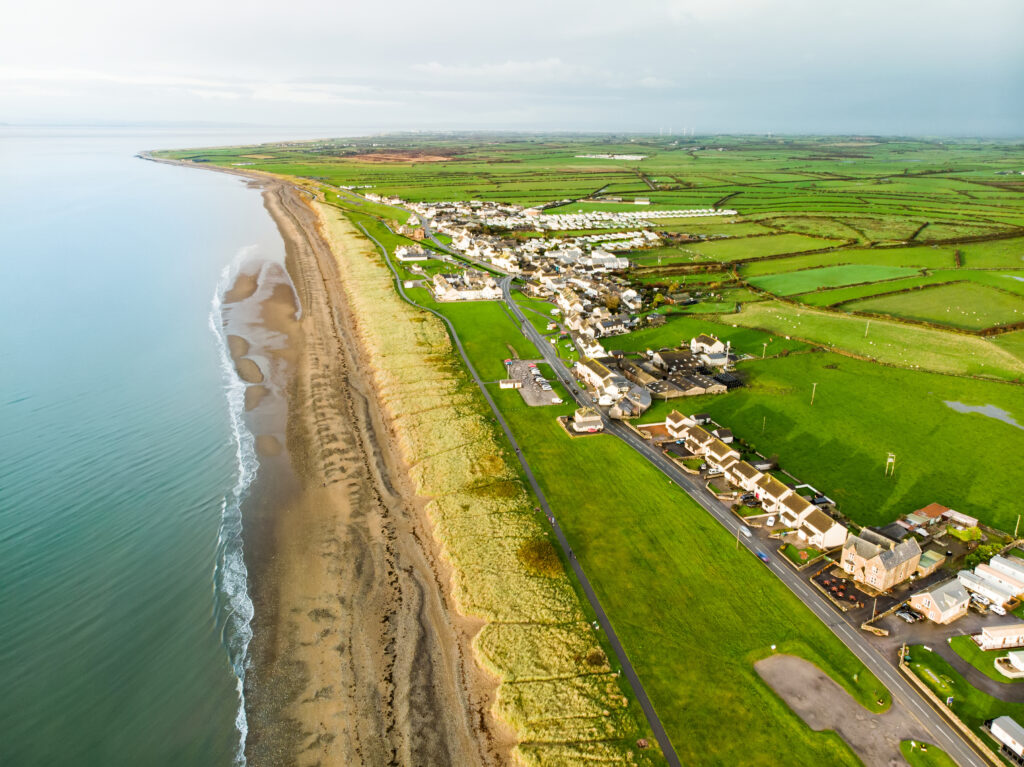
On the Solway Coast, Allonby is a Georgian seaside village with enduring charm. Once a fashionable resort in the 18th and 19th centuries, it drew visitors with its sweeping sandy beach, sea air, and graceful architecture. Georgian terraces still line the main street, recalling that elegant era.
Allonby also has a history of fishing and seafaring. Its position on the Solway Firth provided livelihoods through herring fishing and coastal trade. Today, its harbour and beach remain central to village life.
The surrounding coastline is part of the Solway Coast Area of Outstanding Natural Beauty, rich in wildlife and panoramic views across to Scotland. Walking the shoreline offers peace, history, and natural splendour.
Allonby may be small, but it captures the spirit of Cumberland’s coast: a place where history, community, and seascape come together in harmony.
Silloth
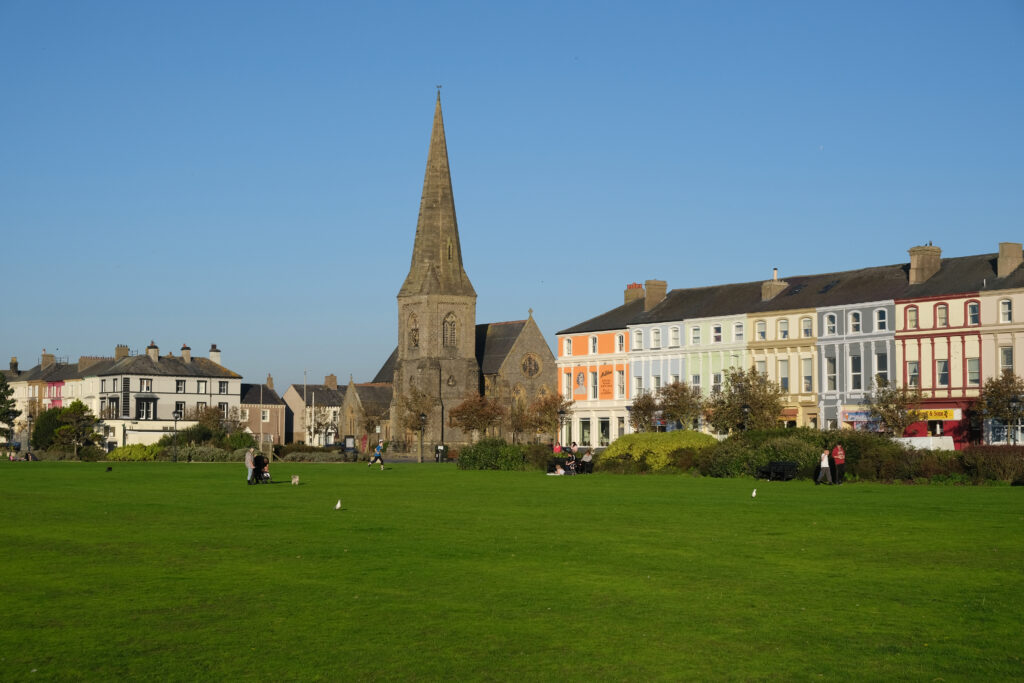
Perched on the Solway Firth, Silloth is a Victorian seaside town created as a planned resort in the mid-19th century. Its broad, grassy Green overlooking the sea is unique, giving the town an open, spacious feel.
Silloth flourished thanks to the arrival of the railway, which brought visitors from Carlisle and beyond. Elegant terraces, wide streets, and ornamental gardens reflect its Victorian heritage. The Christ Church, with its red sandstone spire, dominates the skyline and symbolises the town’s confidence in its heyday.
The town also developed as a small port, handling cargo through its docks, while its seafront promenade continues to attract visitors today. Looking across the Solway, one sees the mountains of Scotland—an ever-changing view of dramatic beauty.
Though quieter now than in its Victorian prime, Silloth remains a place of charm, with its seafront, heritage, and leisurely pace embodying the genteel spirit of a bygone seaside era.
Seascale
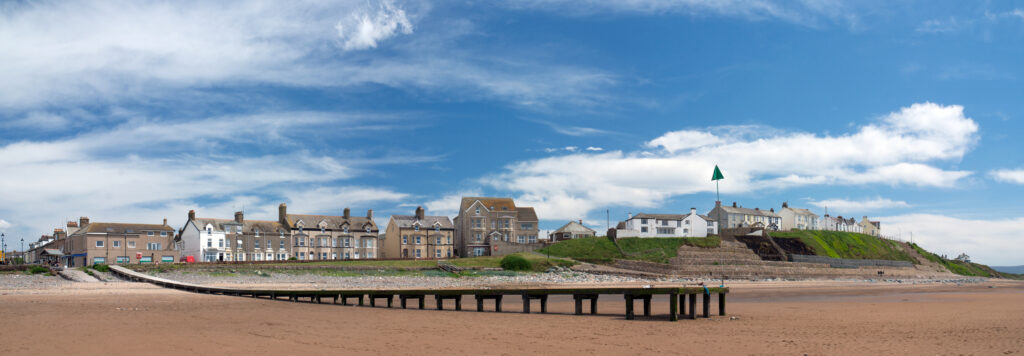
On the west coast lies Seascale, a seaside village that rose to popularity in the Victorian period. With a long sandy beach and views towards the Isle of Man, it offered families fresh air and recreation. A railway connection boosted its appeal, making it a convenient coastal escape.
Seascale’s story later intertwined with industry. Nearby Sellafield, a nuclear power site, became a major employer, giving the area a dual identity: part holiday resort, part industrial community. Despite this, Seascale retains its natural beauty and seaside charm.
Walking along the beach at sunset, with the fells of Wasdale visible inland, is a striking experience. Seascale remains a place where coast and countryside meet, reflecting the evolving story of Cumberland’s communities.
Ravenglass

Unique among Cumberland’s coastal villages, Ravenglass is the only settlement inside the Lake District National Park that sits directly on the coast. Its history is long: it was a Roman naval base, known as Glannoventa, guarding the Cumbrian coast. The remains of a Roman bathhouse still stand, among the best preserved in Britain.
In the medieval period, Ravenglass became a fishing and trading village, connected to the surrounding fells. Today, it is famed as the starting point of the Ravenglass & Eskdale Railway—the “La’al Ratty”—a narrow-gauge line that runs into the heart of Eskdale, beloved by visitors of all ages.
The estuary setting, where three rivers meet the sea, gives Ravenglass a distinctive atmosphere. At sunset, the reflections across the tidal sands are breathtaking.
With its Roman legacy, coastal charm, and railway heritage, Ravenglass is a jewel of the Cumbrian coast.

